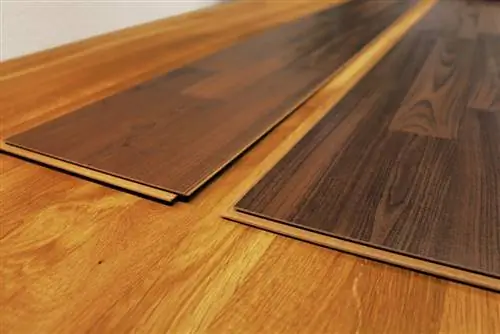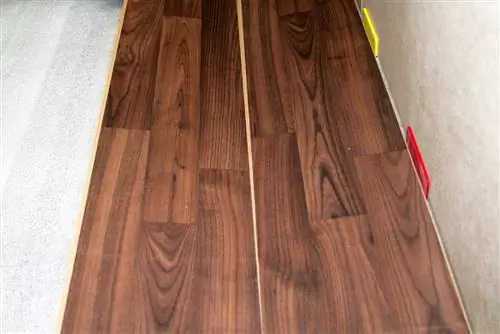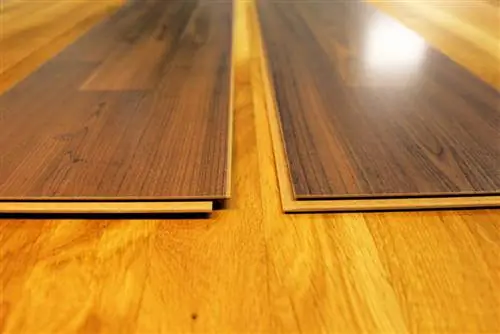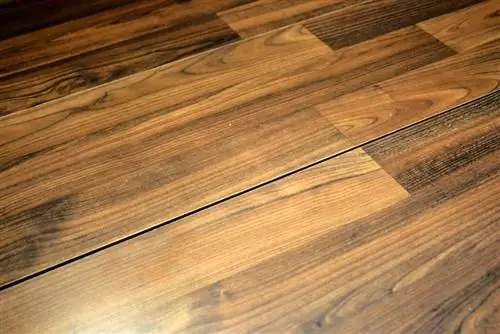- Author admin [email protected].
- Public 2023-12-17 03:39.
- Last modified 2025-06-01 06:48.
The direction in which the laminate is laid determines the effect of the entire room. Therefore, it should be chosen carefully. But what should it depend on and how can you determine in advance which direction is better? We give helpful tips about the optimal direction for laying the laminate.
Light incidence
For a long time, the direction in which the laminate was laid was primarily or even exclusively dependent on the incidence of light in the room in question. In fact, the incidence of light in combination with the direction of installation also has a significant influence on the visual effect.
Embarrassed with the light
If the laminate is laid with the light, there are two advantages. On the one hand, the grain of the laminate seems to literally carry the light into the room. This can make the room appear brighter and friendlier. On the other hand, the joints between the individual sections are not noticeable. The floor appears smoother and more harmonious.
Embarrassed across the light
If the laminate is laid transversely to the light coming through windows, the individual planks appear wider. This can visually stretch the room if it is a very narrow and long basic cut. The potential disadvantage here, however, is that even tiny joints refract the light and are therefore more visually noticeable. This effect becomes even stronger if the floor is cleaned or cared for incorrectly, causing the edges of individual boards to swell.

Unfortunately, the impression is uneven, the floor appears “bumpy” and the joints are annoying. Therefore, on the one hand, greater care must be taken to ensure that the floorboards are laid precisely and maintained correctly. It is also important to ensure that no liquids can leak onto the laminate.
Tip:
Laminate flooring can be sealed with special solutions. If the floor is mopped too wet or something spills on it, this sealing can prevent swelling.
Optical stretching and stretching
In addition to the incidence of light, the basic layout of the respective room should also be taken into account when laying the laminate. Please note that the direction and grain of the laminate have an emphasizing and stretching effect.
Stretch lengthwise
For example, if the laminate is laid lengthways in a long but narrow room and the grain runs parallel to the longer walls, the room will appear even longer - but also narrower. This is not particularly noticeable in a hallway. However, in the living room it can create a negative impression and make the room seem cramped.
Stretch wide
Due to the visual effect, narrow rooms can apparently be widened if the laminate is laid across the long sides. This creates a widening effect and the walls appear to be further apart. This can create a balancing, harmonizing result. But when should you lengthen, stretch or stretch? And when is it better if the direction in which the laminate is laid further emphasizes the basic layout of the room?

Unfortunately there are no general information and dimensions for this. Personal preference also plays a role and the furnishings of the room also have a decisive influence.
Trying is better than studying
In principle there is no wrong laying direction. The direction in which the laminate is laid can only emphasize it less or more or have a balancing effect. Before the floorboards are permanently laid, the visual effect should be checked. This is possible in various ways. These include, among others:
Sketch
Even a simple sketch can show the difference in effect. The scaled outlines are recorded in duplicate. In one sketch the laminate is laid crosswise and in the other sketch it is laid lengthwise. How this stretches, stretches or balances the proportions can at least be guessed at from the sketches.
Loose laying for trial
Once the color, thickness and model of the laminate have been selected, the laminate can be laid on a trial basis (and loosely). Experience has shown that it makes sense to try out both laying options - lengthwise and crosswise - and take photos of them. The photos and the variants in the laying direction make it easier to estimate what will have the better effect in the room.
Consideration time and various comparisons
In order to make an informed decision, various recordings and impressions should be collected. It makes sense to take a photograph morning, afternoon and evening. This allows you to see how the laminate looks under different lighting conditions.

Both installation options can be tried out under different lighting conditions with little effort and a maximum waiting time of two days. This allows a very comprehensive and comparable picture to be created. It is ideal if the photographs are taken from different perspectives and sufficient time for reflection is allowed. This allows the various optical effects to be tested without making a final decision and thus unnecessarily increasing the effort. The laminate can even be laid out on the existing floor covering to get a first, orientative impression.
The advantage of the photos is that they can be compared very easily. Across or lengthways? The respective advantages and disadvantages of the laying direction are very clear in the images.






